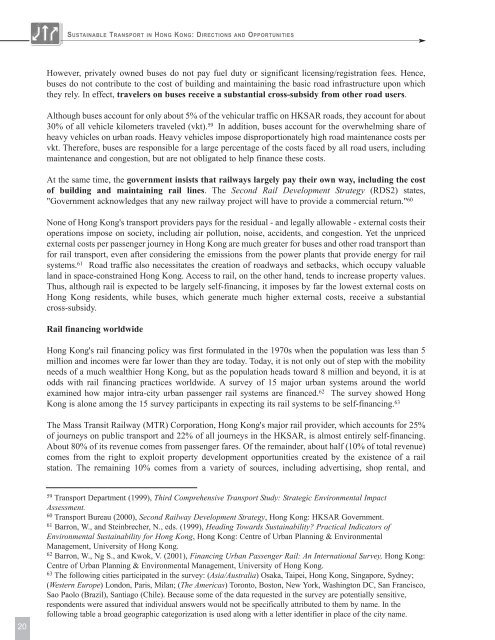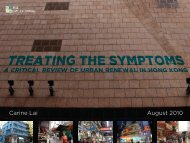Untitled - Civic Exchange
Untitled - Civic Exchange
Untitled - Civic Exchange
You also want an ePaper? Increase the reach of your titles
YUMPU automatically turns print PDFs into web optimized ePapers that Google loves.
SUSTAINABLE TRANSPORT IN HONG KONG: DIRECTIONS AND OPPORTUNITIES<br />
However, privately owned buses do not pay fuel duty or significant licensing/registration fees. Hence,<br />
buses do not contribute to the cost of building and maintaining the basic road infrastructure upon which<br />
they rely. In effect, travelers on buses receive a substantial cross-subsidy from other road users.<br />
Although buses account for only about 5% of the vehicular traffic on HKSAR roads, they account for about<br />
30% of all vehicle kilometers traveled (vkt). 59 In addition, buses account for the overwhelming share of<br />
heavy vehicles on urban roads. Heavy vehicles impose disproportionately high road maintenance costs per<br />
vkt. Therefore, buses are responsible for a large percentage of the costs faced by all road users, including<br />
maintenance and congestion, but are not obligated to help finance these costs.<br />
At the same time, the government insists that railways largely pay their own way, including the cost<br />
of building and maintaining rail lines. The Second Rail Development Strategy (RDS2) states,<br />
"Government acknowledges that any new railway project will have to provide a commercial return." 60<br />
None of Hong Kong's transport providers pays for the residual - and legally allowable - external costs their<br />
operations impose on society, including air pollution, noise, accidents, and congestion. Yet the unpriced<br />
external costs per passenger journey in Hong Kong are much greater for buses and other road transport than<br />
for rail transport, even after considering the emissions from the power plants that provide energy for rail<br />
systems. 61 Road traffic also necessitates the creation of roadways and setbacks, which occupy valuable<br />
land in space-constrained Hong Kong. Access to rail, on the other hand, tends to increase property values.<br />
Thus, although rail is expected to be largely self-financing, it imposes by far the lowest external costs on<br />
Hong Kong residents, while buses, which generate much higher external costs, receive a substantial<br />
cross-subsidy.<br />
Rail financing worldwide<br />
Hong Kong's rail financing policy was first formulated in the 1970s when the population was less than 5<br />
million and incomes were far lower than they are today. Today, it is not only out of step with the mobility<br />
needs of a much wealthier Hong Kong, but as the population heads toward 8 million and beyond, it is at<br />
odds with rail financing practices worldwide. A survey of 15 major urban systems around the world<br />
examined how major intra-city urban passenger rail systems are financed. 62 The survey showed Hong<br />
Kong is alone among the 15 survey participants in expecting its rail systems to be self-financing. 63<br />
The Mass Transit Railway (MTR) Corporation, Hong Kong's major rail provider, which accounts for 25%<br />
of journeys on public transport and 22% of all journeys in the HKSAR, is almost entirely self-financing.<br />
About 80% of its revenue comes from passenger fares. Of the remainder, about half (10% of total revenue)<br />
comes from the right to exploit property development opportunities created by the existence of a rail<br />
station. The remaining 10% comes from a variety of sources, including advertising, shop rental, and<br />
20<br />
59 Transport Department (1999), Third Comprehensive Transport Study: Strategic Environmental Impact<br />
Assessment.<br />
60 Transport Bureau (2000), Second Railway Development Strategy, Hong Kong: HKSAR Government.<br />
61 Barron, W., and Steinbrecher, N., eds. (1999), Heading Towards Sustainability Practical Indicators of<br />
Environmental Sustainability for Hong Kong, Hong Kong: Centre of Urban Planning & Environmental<br />
Management, University of Hong Kong.<br />
62 Barron, W., Ng S., and Kwok, V. (2001), Financing Urban Passenger Rail: An International Survey, Hong Kong:<br />
Centre of Urban Planning & Environmental Management, University of Hong Kong.<br />
63 The following cities participated in the survey: (Asia/Australia) Osaka, Taipei, Hong Kong, Singapore, Sydney;<br />
(Western Europe) London, Paris, Milan; (The Americas) Toronto, Boston, New York, Washington DC, San Francisco,<br />
Sao Paolo (Brazil), Santiago (Chile). Because some of the data requested in the survey are potentially sensitive,<br />
respondents were assured that individual answers would not be specifically attributed to them by name. In the<br />
following table a broad geographic categorization is used along with a letter identifier in place of the city name.

















